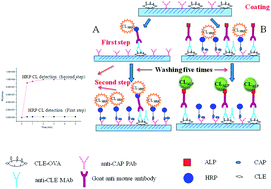
Hybrid chemiluminescence immunoassays
The transfer of veterinary drugs into food products is of major concern to a world already struggling to combat antibiotic resistance. Antibiotics such as chloramphenicol also have serious side effects in humans, including bone marrow depression and acute leukemia. Despite government bans on the use of such drugs in food-producing animals in a number of countries, cases of food poisoning caused by contaminated meat continue to occur.
Researchers led by Hiayang Jiang at the China Agricultural University in Beijing have developed a novel method for the analysis of two key drugs, chloramphenicol (CAP) and clenbuterol (CLE), which can simultaneously detect trace amounts of each compound in milk samples.
Traditional detection methods have relied on gas and liquid chromatography, and mass spectrometry, which require expensive instrumentation and highly trained technicians. Jiang and coworkers have designed a hybrid chemiluminescence immunoassay to detect trace amounts of CAP and CLE in a single analysis, with minimal cost and time requirements.
This paper will be free to read until the 27th of February 2014.
Simultaneous determination of chloramphenicol and clenbuterol in milk with hybrid chemiluminescence immunoassays
Xiaoqi Tao, Jianzhong Shen, Xingyuan Cao, Zhanhui Wang, Xiaoping Wu and Haiyang Jiang
Anal. Methods, 2014, Advance Article
DOI: 10.1039/C3AY41744A










